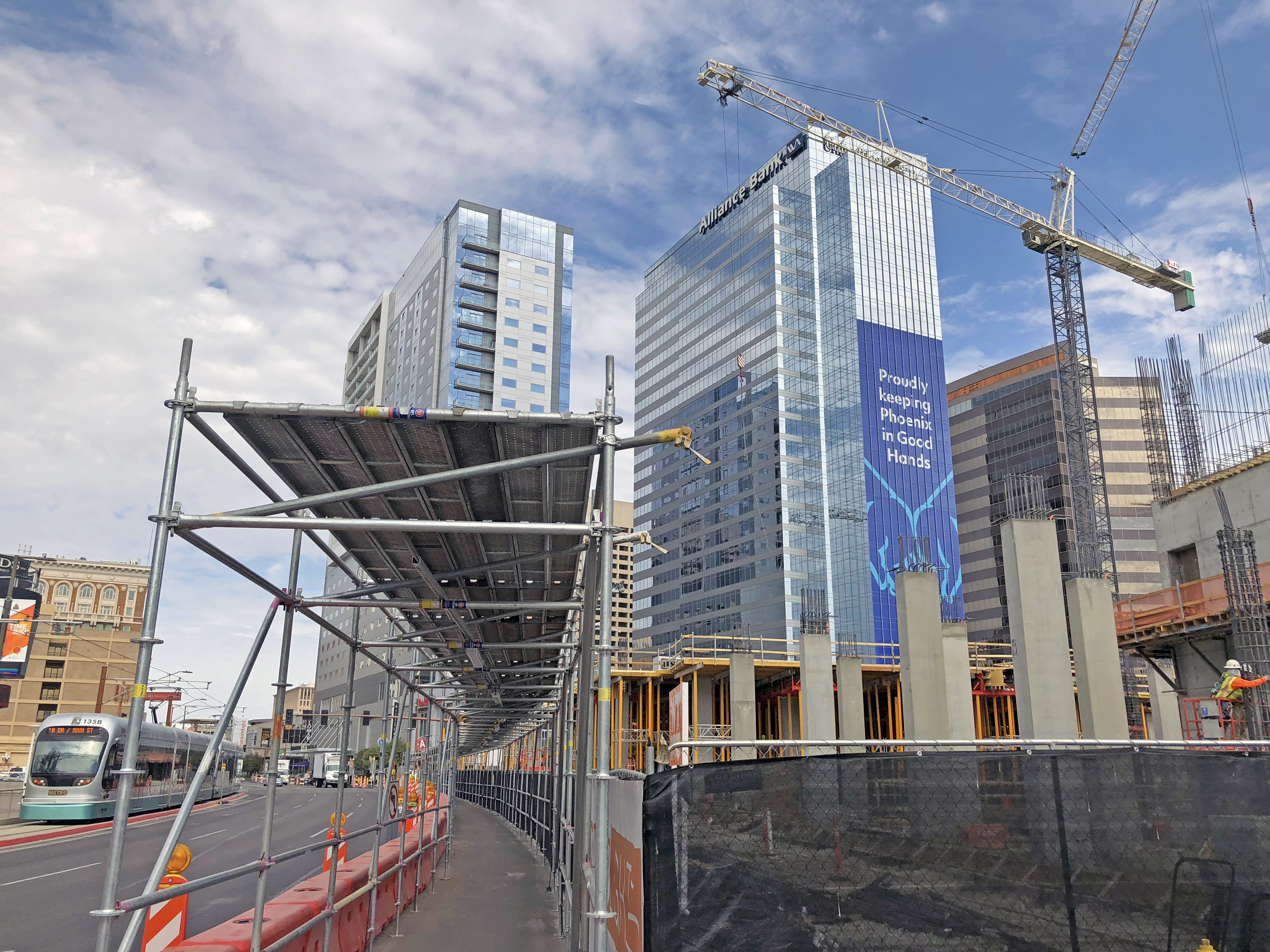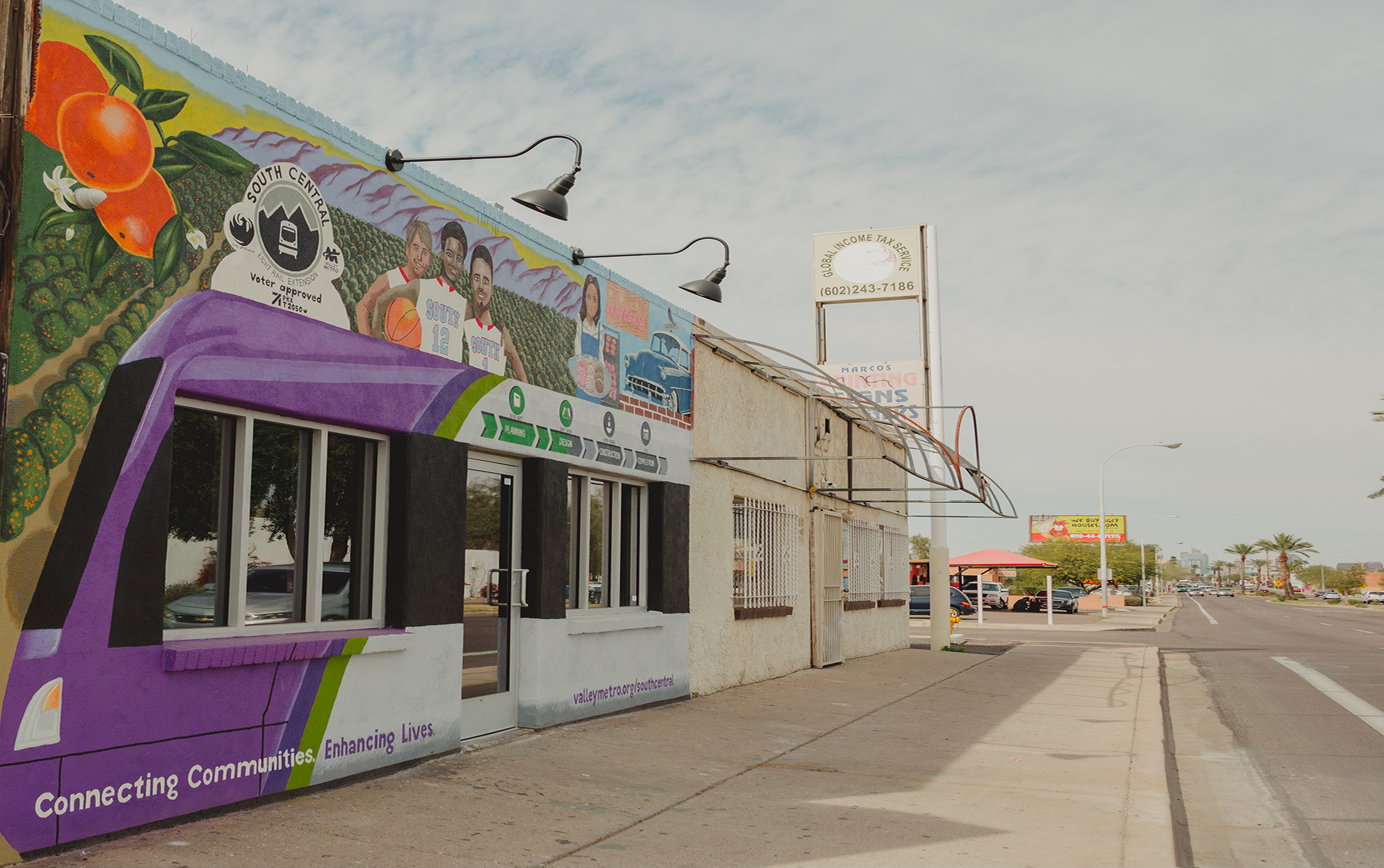- Things to do
- Eat & Drink
- Music
- Pro Sports
- Getting Around
- Shopping & Services
- Hotels
- Arts & Culture
- Tours
- What’s Happening
Browse by category

A mixed use high-rise, which includes a Fry’s grocery store, is currently under construction adjacent to light rail in Downtown Phoenix. (Photo: Fara Illich)
When the Proposition 104 transit tax appeared on the ballot in 2015, Maria Elena Coronado knew she would support it.
As a south Phoenix resident for 46 years, she saw the need for road improvements, better bus services, and safer walkways for pedestrians. She also supported the south-side extension of light rail.
“It’s been a longtime vision of mine after seeing the success in downtown and the rest of the Valley,” she said. “I love how it allows people to explore the community.”
Slated for construction beginning next year, the six-mile light rail extension from Downtown Phoenix to Baseline Road will connect people to things like work, school, key services and amenities. It could also open a window of opportunities for a traditionally underserved population.
Many of the residents along the south central light rail corridor greatly depend on public transit, without enjoying equal access to it. According to a 2015 health impact report, 27 percent of people along the proposed new route were totally transit-dependent (car-free) — compared to 12 percent in Maricopa County.
In the study area — spanning from McDowell Road to the north and Dobbins Road to the south, 15th Avenue to the west and 16th Street to the east — people also tended to be younger, primarily Latino, and make less money on average.
The short-term goal is to connect transit to a population that needs it, according to Scott Smith, Valley Metro CEO, but he said the long-term impact is generational, changing lives and communities for the better.
“With these projects, its much more than just transporting people from point A to point B,” he said. “We literally have an impact on communities that is game-changing.”
A significant amount of private investment followed the first 26 miles of light rail, and Smith said he believes this project will yield similar results. The key is ensuring local residents and small businesses reap the benefits — not just outside developers.
It’s “a careful balance,” according to Sam Gomez, owner of the Sagrado Galleria on Central Avenue, just south of Southern Avenue. Like many in the community, he worries about the negative impacts of gentrification, and how the construction phase could shutter some local businesses.
“South Phoenix has a lot of history, a lot of diversity, let’s preserve that,” he said. “The land, the spirit of the people, it’s indigenous history — it’s a very unique place.”

Japanese farmers found success in south Phoenix’s early years, growing a growing a variety of vegetables and flowers. (Photo: Arizona Library)
The neighborhoods of south Phoenix date back to the founding of the city, when the first commercial warehouses opened on the south side of the Union Pacific Railroad in 1887, and farming took off near the Salt River. Industrial and agricultural jobs attracted many Latino and African American farm workers, who settled, worked the land, and created communities here.
But not without facing extreme prejudice along the way.
With school and housing segregation, it was one of the few places people of color could buy property, attend schools, churches, and set up businesses. After more than 100 years, it remains a predominantly Latino community today.
Even though south Phoenix technically begins at the Salt River, the railroad tracks became the physical and symbolic dividing line between north and south.
“When you cross the bridge going over Central Avenue, it’s like you’re going into a new place,” Gomez said.
Just beyond the industry of the Warehouse District, south Phoenix was mostly rural, even through the 1970s, with giant orchards, fields and ranches. Lush flower gardens lined Baseline Road, which were remnants of Phoenix’s early Japanese farming community.
Recent public expenditures in housing, infrastructure and cultural amenities aided in its urbanization, but decades of disinvestment in water lines, sewage, roads, sidewalks and other services left south Phoenix behind. Much of it remained outside city limits without political representation until annexations in 1959 and ‘60.
The light rail extension represents a major public investment. It’s expected to cost more than $900 million, funded through voter-approved transportation taxes (Prop 104 and Prop 400), with the bulk of it — $595 million — coming from federal funds.
Studies on the need and feasibility of a light rail line into south Phoenix started almost as soon as the initial 20-mile route was built. Over the past seven years, Valley Metro has conducted hundreds of meetings, presentations, interviews and input sessions.

A small group of community organizers protested outside Valley Metro’s new community office in south Phoenix on June 9. (Photo: Valley Metro)
But some critics say it wasn’t enough. A group of business owners opposing the project argue the process wasn’t transparent, and have taken issue with the reduction of traffic lanes on Central Avenue to one in each direction.
City council voted to look at redesigning the line to maintain four vehicular lanes, but that comes with trade offs. The lane reduction makes space for bike lanes, ADA-compliant sidewalks, and streetscape elements like shade trees, which will all have to be reconsidered.
Since the design phase launched in January, there have been a series of heated community meetings, City Council sessions, protests, and a petition to change the lane configuration or halt the project — which received thousands of signatures.
Currently, the project is still on track to meet federal deadlines to ensure funding, and both the City of Phoenix and Valley Metro have pitched in to create the light rail program’s largest business assistance program to date.
The construction phase will undoubtedly affect residents and businesses, but according to David Krietor, CEO of Downtown Phoenix Inc., you have to balance that against all the collective benefits — namely jobs.
“Light rail will provide an opportunity for people to have access to great services and amenities, access to great K-12 schools, university education, and provide access to hundreds of thousands of jobs,” said David Krietor, CEO of Downtown Phoenix Inc. “It’s going to forever connect and provide opportunity to a part of the city that perhaps has not had the opportunities it’s deserved.”
In addition to bringing people from south Phoenix to downtown and elsewhere in the Valley, Coronado said she’s most excited about bringing new people in, and showcasing what south Phoenix has to offer.
“I’m excited for the people who have always been afraid of south Phoenix to come down,” she said. “They’re bringing a different vein into the community that I think a lot of people from outside have not been able to experience.”